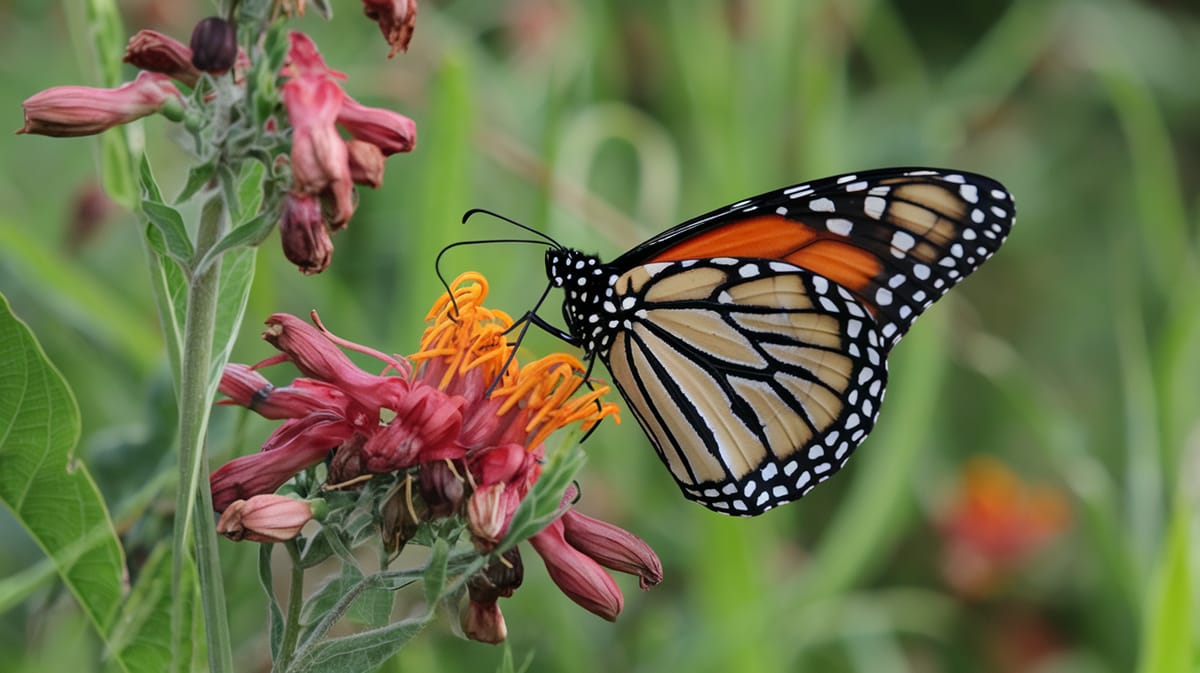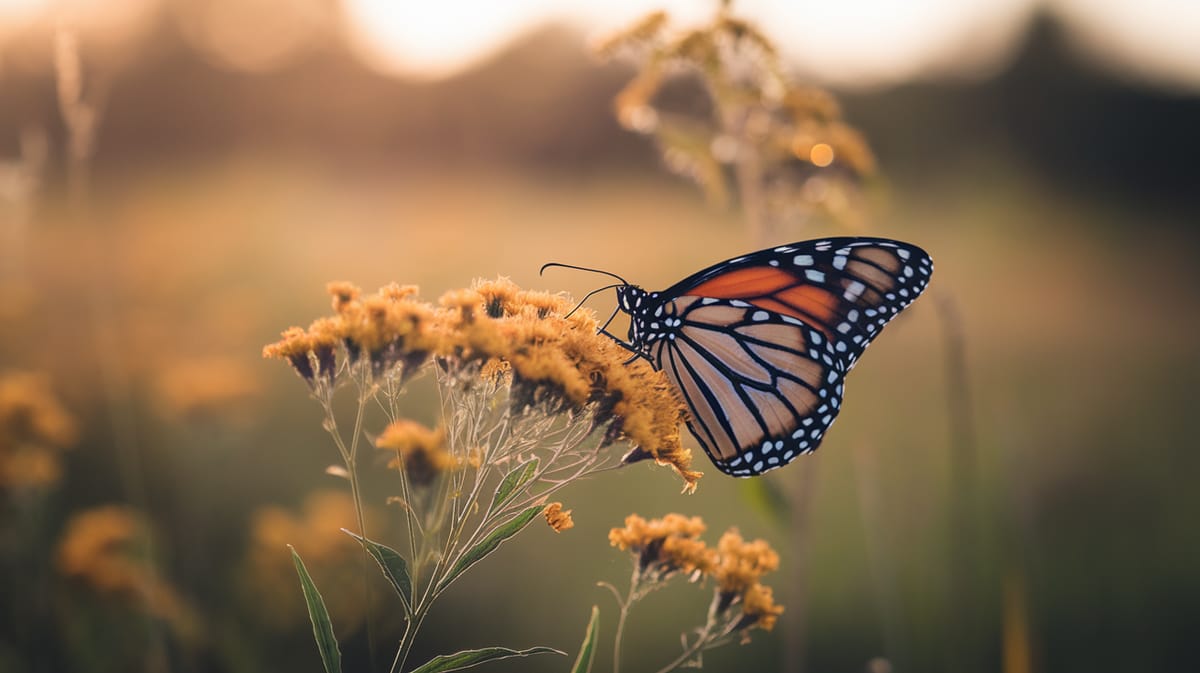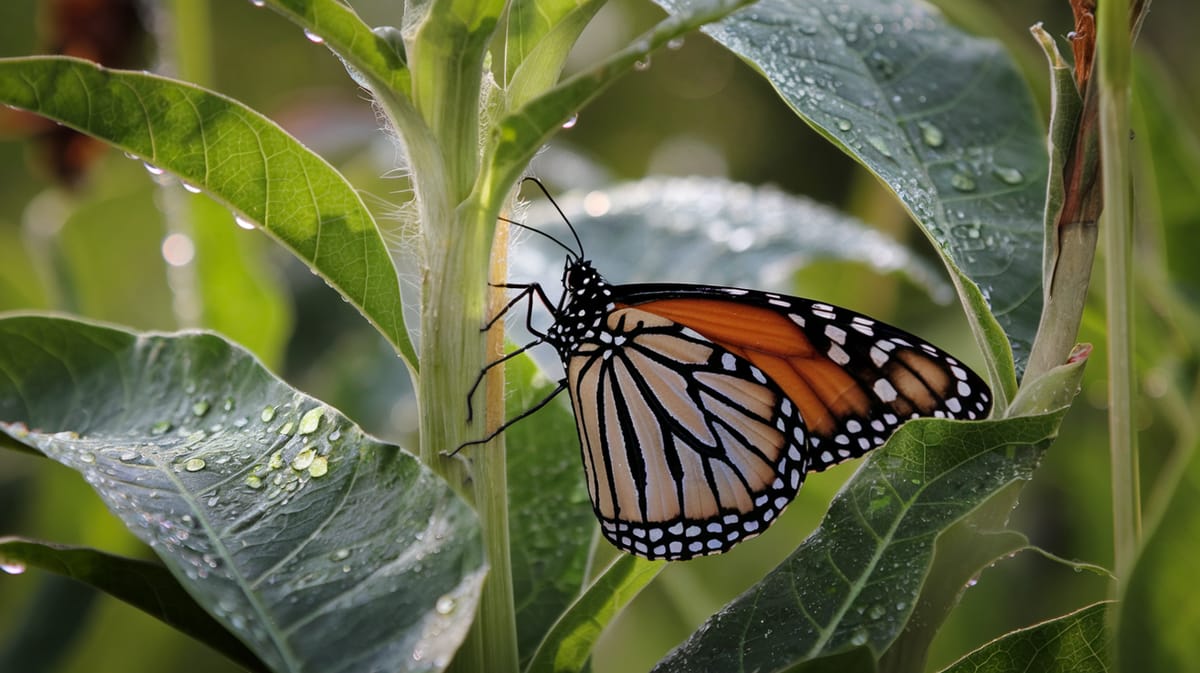Monarch Butterfly
Majestic traveler across continents, the Monarch Butterfly enchants with its vibrant orange wings and epic migration. Its vital role in pollination supports diverse ecosystems.

Key Insights at a Glance
Did You Know?
Taxonomy & Classification
Renowned for their incredible migratory patterns, Monarch butterflies exhibit distinctive orange and black coloration, serving as a warning to predators. Let's understand the evolutionary journey and classification of these remarkable pollinators.
Global Presence
Monarch butterflies are found across North America, Australia, and even some Pacific Islands, showcasing their adaptability to diverse environments.
Evolutionary Adaptations
Evolving around 2 million years ago, they developed milkweed toxicity resistance, aiding their survival against predators and contributing to their migratory success.
Lifecycle and Growth
A remarkable journey of transformation from Egg to Adult.
Egg
Tiny, cream-colored eggs are laid on milkweed leaves, providing essential nutrients for the emerging larva.
Larva
The caterpillar devours milkweed, growing rapidly and molting five times to accommodate its expanding body.
Pupa
Encased in a green chrysalis, dramatic metamorphosis occurs as tissues reorganize into adult structures.
Adult
Vibrant orange and black wings emerge, facilitating migration and reproduction essential for species survival.
Dietary Habits
A skilled nectar forager with specialized feeding habits, this insect relies on its proboscis for extracting liquid food.
| DIET TYPE | DESCRIPTION |
|---|---|
| Primary Diet | Feeds primarily on milkweed plants, obtaining essential nutrients and toxins for defense. |
| Secondary Diet | Consumes nectar from a variety of flowering plants, supplementing its diet with diverse sources. |
| Occasional | Occasionally sips water from damp soil or puddles, especially in hot and dry conditions. |

Behaviour and Adaptations
Discover the extraordinary traits that enable the Monarch Butterfly to thrive across vast distances and environments.
Migration Expertise
Undertakes a remarkable migratory journey spanning thousands of miles for survival.
Toxicity Defense
Utilizes toxins from milkweed to deter predators, making them undesirable prey.
Temperature Regulation
Basks in the sun to raise body temperature for flight.
Ecosystem Impact
Monarch Butterflies play a crucial role in ecosystem sustainability and balance.
Pollination Partners
Assist in pollinating various wildflower species, supporting biodiversity and plant reproduction.
Food Chain Support
Serve as a food source for birds, small mammals, and other predators.
Migration Influence
Their migration aids in the distribution of seeds and genetic diversity across vast distances.
Conservation Challenges
Understanding and addressing the major threats to Monarch Butterfly populations.
Habitat Loss
Urbanization and agriculture reduce milkweed availability, crucial for larval development.
Pesticide Use
Chemicals harm Monarchs and their habitats, disrupting their life cycle.
Climate Change
Temperature shifts alter migration patterns and breeding success.
Frequently Asked Questions
How long do Monarch Butterfly live?
Monarch butterflies typically live for two to six weeks as adults. However, the migratory generation, which emerges in late summer, can live up to eight months to survive the journey to their overwintering sites.
What do Monarch Butterfly eat?
Monarch butterfly caterpillars exclusively eat milkweed leaves, which provide them with toxins for defense. Adult monarchs feed on nectar from a variety of flowers, using their long proboscis to sip the sugary liquid that fuels their energy needs.
Are Monarch Butterfly poisonous?
Monarch butterflies themselves are not poisonous, but they are toxic to predators. Through consuming milkweed as caterpillars, they store cardenolides, chemicals that are distasteful and can cause illness in birds and other predators that attempt to eat them.
Are Monarch Butterfly endangered?
Monarch butterflies are not currently listed as endangered, but their populations are declining due to habitat loss, climate change, and pesticide use. Conservation efforts focus on preserving their breeding and migratory habitats and increasing the availability of milkweed.
What do Monarch Butterfly symbolize?
Monarch butterflies often symbolize transformation and rebirth due to their life cycle from caterpillar to butterfly. They are also seen as symbols of endurance and hope, representing the spirit of migration and the interconnectedness of ecosystems.
Do Monarch Butterfly bite?
Monarch butterflies do not bite humans. They do not have mouthparts capable of biting or chewing. Instead, they have a proboscis, a long tube-like tongue used to suck nectar from flowers.
What color are Monarch Butterfly?
Monarch butterflies are easily recognized by their striking orange and black wings. Their wings are bordered with black and dotted with white spots, creating a vivid contrast that serves as a warning to predators about their toxicity.
Does a Monarch Butterfly have wings?
Yes, monarch butterflies have wings. They possess two pairs of large, colorful wings that enable them to fly long distances, especially during their annual migration from North America to central Mexico.
What does a Monarch Butterfly look like?
Monarch butterflies are known for their bright orange wings with black veins and white spots along the edges. They have a wingspan of about 3.5 to 4 inches. Their bodies are black with white spots, contributing to their distinctive appearance.
Is a Monarch Butterfly an insect?
Yes, the monarch butterfly is an insect. It belongs to the order Lepidoptera, which includes all butterflies and moths. Like other insects, monarchs have three main body parts: head, thorax, and abdomen, along with six legs and two pairs of wings.
Related Insects
Discover insects with similar characteristics to Monarch Butterfly - including shared habitats, diets, and taxonomic classifications
Share this profile
Help others discover Monarch Butterfly
